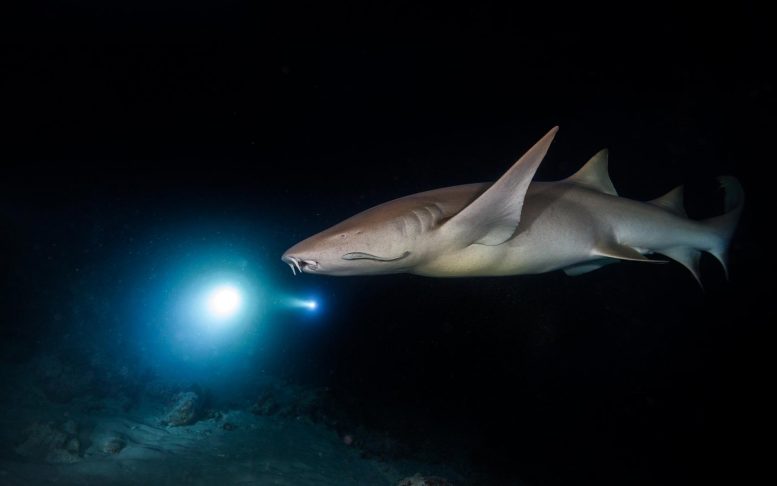
Sharks rely on magnetic fields for their long-distance journeys across the sea.
Sea turtles are known for relying on magnetic signatures to find their way across thousands of miles to the very beaches where they hatched. Now, researchers reporting in the journal Current Biology on May 6, 2021, have some of the first solid evidence that sharks also rely on magnetic fields for their long-distance forays across the sea.
“It had been unresolved how sharks managed to successfully navigate during migration to targeted locations,” said Save Our Seas Foundation project leader Bryan Keller, also of Florida State University Coastal and Marine Laboratory. “This research supports the theory that they use the earth’s magnetic field to help them find their way; it’s nature’s GPS.”
Researchers had known that some species of sharks travel over long distances to reach very specific locations year after year. They also knew that sharks are sensitive to electromagnetic fields. As a result, scientists had long speculated that sharks were using magnetic fields to navigate. But the challenge was finding a way to test this in sharks.
“To be honest, I am surprised it worked,” Keller said. “The reason this question has been withstanding for 50 years is because sharks are difficult to study.”
Keller realized the needed studies would be easier to do in smaller sharks. They also needed a species known for returning each year to specific locations. He and his colleagues settled on bonnetheads (Sphyrna tiburo).
“The bonnethead returns to the same estuaries each year,” Keller said. “This demonstrates that the sharks know where ‘home’ is and can navigate back to it from a distant location.”
The question then was whether bonnetheads managed those return trips by relying on a magnetic map. To find out, the researchers used magnetic displacement experiments to test 20 juvenile, wild-caught bonnetheads. In their studies, they exposed sharks to magnetic conditions representing locations hundreds of kilometers away from where the sharks were actually caught. Such studies allow for straightforward predictions about how the sharks should subsequently orient themselves if they were indeed relying on magnetic cues.
This video is footage from an experimental trial, where the bonnethead’s swimming behavior is affected by the magnetic field it is experiencing. Credit: Bryan Keller
If sharks derive positional information from the geomagnetic field, the researchers predicted northward orientation in the southern magnetic field and southward orientation in the northern magnetic field, as the sharks attempted to compensate for their perceived displacement. They predicted no orientation preference when sharks were exposed to the magnetic field that matched their capture site. And, it turned out, the sharks acted as they’d predicted when exposed to fields within their natural range.
The researchers suggest that this ability to navigate based on magnetic fields may also contribute to the population structure of sharks. The findings in bonnetheads also likely help to explain impressive feats by other shark species. For instance, one great white shark was documented to migrate between South Africa and Australia, returning to the same exact location the following year.

This figure shows how the experiment assessed the ability of bonnethead sharks to use the Earth’s magnetic field to navigate. Credit: Keller et al./Current Biology
“How cool is it that a shark can swim 20,000 kilometers round trip in a three-dimensional ocean and get back to the same site?” Keller asked. “It really is mind blowing. In a world where people use GPS to navigate almost everywhere, this ability is truly remarkable.”
In future studies, Keller says he’d like to explore the effects of magnetic fields from anthropogenic sources such as submarine cables on sharks. They’d also like to study whether and how sharks rely on magnetic cues not just during long-distance migration but also during their everyday behavior.
Reference: “Map-like use of Earth’s magnetic field in sharks” by Bryan A. Keller, Nathan F. Putman, R. Dean Grubbs, David S. Portnoy and Timothy P. Murphy, 6 May 2021, Current Biology.
DOI: 10.1016/j.cub.2021.03.103
This work was supported by the Save Our Seas Foundation and the Florida State University Coastal and Marine Laboratory.










So when the poles swap, will the whale sharks swim south and bump into Antarctica?
Pretty cool experiment, not to mention interesting results!
We should also know whether whales get disoriented because of man made disturbances of earth’s magnetic field in the sea!